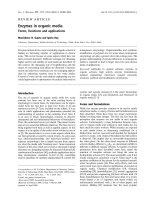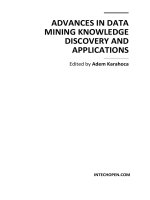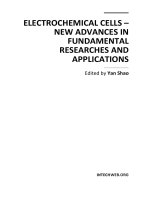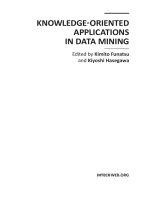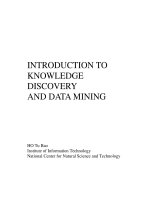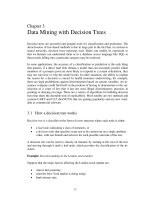ADVANCES IN DATA MINING KNOWLEDGE DISCOVERY AND APPLICATIONS pot
Bạn đang xem bản rút gọn của tài liệu. Xem và tải ngay bản đầy đủ của tài liệu tại đây (14.13 MB, 430 trang )
ADVANCES IN DATA
MINING KNOWLEDGE
DISCOVERY AND
APPLICATIONS
Edited by Adem Karahoca
Advances in Data Mining Knowledge Discovery and Applications
Edited by Adem Karahoca
Contributors
Dost Muhammad Khan, Nawaz Mohamudally, D. K. R. Babajee, Tomas Borovicka, Marcel Jirina
Jr., Pavel Kordik, Marcel Jirina, Carmelo Cassisi, Placido Montalto, Marco Aliotta, Andrea
Cannata, Alfredo Pulvirenti, Fadzilah Siraj, Ehab A. Omer A. Omer, Md. Rajib Hasan,
Mohammad Lutfi Othman, Ishak Aris, Xingping Wen, Xiaofeng Yang, Maria Madalena Dias,
Juliana Keiko Yamaguchi, Emerson Rabelo, Clélia Franco, Kohsuke Yanai, Toshihiko Yanase,
Lilian Freitas, Yomara Pires, Jefferson Morais, João Costa, Aldebaro Klautau, José C. Reston
Filho, Carolina de M. Affonso, Roberto Célio L. de Oliveira, Intan Azmira binti Wan Abdul
Razak, Shah bin Majid, Mohd Shahrieel bin Mohd. Aras, Arfah binti Ahmad, Ghulam Mujtaba
Shaikh, Tariq Mahmood, Matthew Watts, Robert Carrese, Hadi Winarto, R.L.K.Venkateswarlu,
R. Raviteja, R. Rajeev, Gao Jie, Dewan Md. Farid, Mohammad Zahidur Rahman, Chowdhury
Mofizur Rahman, Erdem Alparslan, Adem Karahoca, Dilek Karahoca, Adela Bâra, Ion Lungu
Published by InTech
Janeza Trdine 9, 51000 Rijeka, Croatia
Copyright © 2012 InTech
All chapters are Open Access distributed under the Creative Commons Attribution 3.0 license,
which allows users to download, copy and build upon published articles even for commercial
purposes, as long as the author and publisher are properly credited, which ensures maximum
dissemination and a wider impact of our publications. After this work has been published by
InTech, authors have the right to republish it, in whole or part, in any publication of which they
are the author, and to make other personal use of the work. Any republication, referencing or
personal use of the work must explicitly identify the original source.
Notice
Statements and opinions expressed in the chapters are these of the individual contributors and
not necessarily those of the editors or publisher. No responsibility is accepted for the accuracy
of information contained in the published chapters. The publisher assumes no responsibility for
any damage or injury to persons or property arising out of the use of any materials,
instructions, methods or ideas contained in the book.
Publishing Process Manager Mirna Cvijic
Typesetting InTech Prepress, Novi Sad
Cover InTech Design Team
First published September, 2012
Printed in Croatia
A free online edition of this book is available at www.intechopen.com
Additional hard copies can be obtained from
Advances in Data Mining Knowledge Discovery and Applications,
Edited by Adem Karahoca
p. cm.
ISBN 978-953-51-0748-4
Contents
Preface IX
Section 1 Knowledge Discovery 1
Chapter 1 Towards the Formulation of a Unified Data Mining Theory,
Implemented by Means of Multiagent Systems (MASs) 3
Dost Muhammad Khan, Nawaz Mohamudally and D. K. R. Babajee
Chapter 2 Selecting Representative Data Sets 43
Tomas Borovicka, Marcel Jirina Jr., Pavel Kordik and Marcel Jirina
Chapter 3 Similarity Measures and Dimensionality
Reduction Techniques for Time Series Data Mining 71
Carmelo Cassisi, Placido Montalto, Marco Aliotta,
Andrea Cannata and Alfredo Pulvirenti
Chapter 4 Data Mining and Neural Networks:
The Impact of Data Representation 97
Fadzilah Siraj, Ehab A. Omer A. Omer and Md. Rajib Hasan
Chapter 5 Inconsistent Decision System:
Rough Set Data Mining Strategy to Extract Decision
Algorithm of a Numerical Distance Relay – Tutorial 117
Mohammad Lutfi Othman and Ishak Aris
Chapter 6 An Unsupervised Classification Method for Hyperspectral
Remote Sensing Image Based on Spectral Data Mining 143
Xingping Wen and Xiaofeng Yang
Chapter 7 Visualization Techniques: Which is the Most Appropriate
in the Process of Knowledge Discovery in Data Base? 155
Maria Madalena Dias, Juliana Keiko Yamaguchi,
Emerson Rabelo and Clélia Franco
Chapter 8 Analysis and Learning Frameworks
for Large-Scale Data Mining 181
Kohsuke Yanai and Toshihiko Yanase
VI Contents
Section 2 Data Mining Applications 197
Chapter 9 Data Mining Applied to Cognitive Radio Systems 199
Lilian Freitas, Yomara Pires, Jefferson Morais,
João Costa and Aldebaro Klautau
Chapter 10 Short-Term Energy Price Prediction Multi-Step-Ahead
in the Brazilian Market Using Data Mining 219
José C. Reston Filho, Carolina de M. Affonso
and Roberto Célio L. de Oliveira
Chapter 11 Electricity Load Forecasting
Using Data Mining Technique 235
Intan Azmira binti Wan Abdul Razak, Shah bin Majid,
Mohd Shahrieel bin Mohd. Aras and Arfah binti Ahmad
Chapter 12 Mining and Adaptivity in Automated Teller Machines 255
Ghulam Mujtaba Shaikh and Tariq Mahmood
Chapter 13 Data Mining for Motorsport Aerodynamics 281
Matthew Watts, Robert Carrese and Hadi Winarto
Chapter 14 The Performance Evaluation of Speech
Recognition by Comparative Approach 311
R.L.K. Venkateswarlu, R. Raviteja and R. Rajeev
Chapter 15 Data Mining from Remote Sensing
Snow and Vegetation Product 337
Gao Jie
Chapter 16 Mining Complex Network Data
for Adaptive Intrusion Detection 357
Dewan Md. Farid, Mohammad Zahidur Rahman
and Chowdhury Mofizur Rahman
Chapter 17 BotNet Detection: Enhancing Analysis
by Using Data Mining Techniques 379
Erdem Alparslan, Adem Karahoca and Dilek Karahoca
Chapter 18 Improving Decision Support
Systems with Data Mining Techniques 397
Adela Bâra and Ion Lungu
Preface
Advances in Knowledge Discovery and Data Mining aims to help data miners, researchers,
scholars, and PhD students who wish to apply data mining techniques. The primary
contribution of this book is highlighting frontier fields and implementations of the
knowledge discovery and data mining. It seems to be same things are repeated again.
But in general, same approach and techniques may help us in different fields and
expertise areas. This book presents knowledge discovery and data mining applications
in two different sections. As known that, data mining covers areas of statistics,
machine learning, data management and databases, pattern recognition, artificial
intelligence, and other areas. In this book, most of the areas are covered with different
data mining applications. The eighteen chapters have been classified in two parts:
Knowledge Discovery and Data Mining Applications.
First part of the book consists of the first and second phases of the knowledge
discovery. Second part focuses on the data mining applications from energy,
electricity, speech recognition and network security.
Section 1. Knowledge Discovery
Chapter 1 presents the mathematical formulation of unified theory of data mining and
multi agent system architecture. The data mining processes clustering, classification
and visualization are unified by means of mathematical functions and multi agent
system is developed (Khan, et al.).
Chapter 2 focuses on an overview of existing methods that deal with methods of data
selection and sampling (Borovicka, et al.).
Chapter 3 provides an overview of main dimensionality reduction algorithms,
together with a detailed description of the most used similarity measures in time series
data mining (Cassisi, et al.).
Chapter 4 explorers the effect of different data representations on the performance of
neural network and regression was investigated on different datasets that have binary
or Boolean class target (Siraj, et al.).
X Preface
Chapter 5 proposes employing rough set theory to obtain the knowledge about the
distance protective relay under supervised learning (Othman and Aris).
Chapter 6 presents an unsupervised classification for hyperspectral remote sensing
image. It can effectively extract the low reflectance object such as vegetation in
shadowed region or water from hyperspectral image using spectral data mining (Wen,
et al.).
Chapter 7 demonstrates that there are some parameters to be considered in the choice
of visualization techniques, which are: data type, task type, data scalability, data
dimension and position of the attributes in the display. Also presents the application
of geometrical and iconographic techniques over results of clustering algorithm with
the objective of illustrate the contribution of the guidelines (Madalena, et al.).
Chapter 8 proposes two computing frameworks for large-scale data mining via tree
structured data analysis framework and parallel machine learning framework (Yanai
and Yanase).
Section 2. Data Mining Applications
Chapter 9 discusses the task of modulation classification in cognitive radio. The
modulation classification becomes fundamental, since this information allows the RC
to adapt its transmission parameters for the spectrum to be shared efficiently, without
causing interference to other users (Freitas, et al.).
Chapter 10 proposes a methodology combining ARIMA and Artificial Neural
Network (ANN) for short-term energy price prediction multi-step-ahead in the
Brazilian market (Filho, et al.).
Chapter 11 offers data mining application for short term electricity load forecasting to
organize supply and demand fluctuations (Razak, et al.).
Chapter 12 proposes a set of five adaptive ATM interfaces, which are adapted to the
behavior of an ATM customer population (Shaikh and Mahmood).
Chapter 13 details a design space exploration upon a low speed aerofoil section for the
front wing of a Formula One vehicle. In order to obtain a complete understanding of
the design space, two data mining techniques were considered. For qualitative
information Self-Organising Map (SOM) was applied while Analysis Of Variance
(ANOVA) was used to highlight the quantitative response (Watts, et al.).
Chapter 14 benchmarks the different data mining techniques to obtain best speech
recognition (Venkateswarlu, et al.).
Chapter 15 suggests remote sensing data. Elevation as a variable is considered in
spatial distribution of snow, vegetation will be used as an indicator. Also chapter
investigates (1) quantification of SCA (Snow-Cover Area per unit area of elevation
Preface XI
band) – Elevation relations and NDVI-Elevation relations; (2) comparisons among
Snow-Elevation-Vegetation relations, to obtain a better understanding of snow-
covered area vary with elevation, and the relation to vegetation by using a quantitative
method to detect the Snow-NDVI-Elevation relation (Jie).
Chapter 16 compares the perfomances of recently developed data mining algorithms
for adaptive intrusion detection, which scale up the detection rates (DR) for different
types of network intrusions and reduce the false positives (FP) at acceptable level in
intrusion detection (Farid, et al.).
Chapter 17 reviews botnet detection, attack types caused by botnets and well-known
botnet classifications and diverse types of detection techniques (Alparslan, et al.).
Chapter 18 proposes applying data mining for forecasting the wind power plants’
energy production (Bâra and Lungu).
I would like to thank all the authors for their contributions, and the InTech Publishing
team for their helpful assistance, and last but not least, the people who help
disseminate this book. I hope that this book will inspire readers to pursue education
and research in emerging field of data mining.
Assoc.Prof.Dr. Adem Karahoca
Bahcesehir University, Engineering Faculty,
Head of Software Engineering Department, Istanbul,
Turkey
Section 1
Knowledge Discovery
